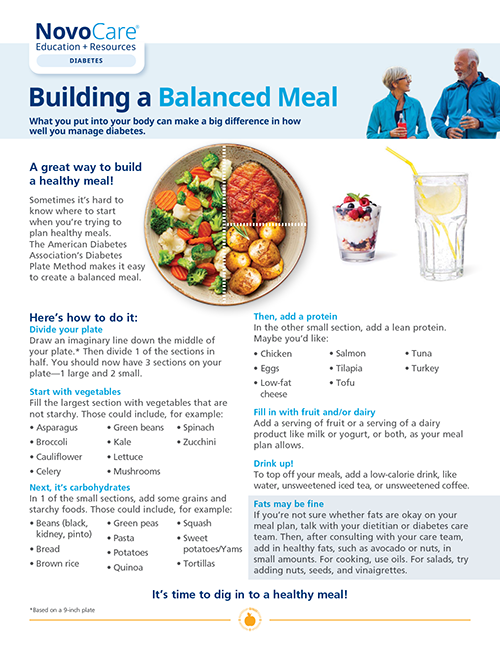
EATING
Digging in...
to the food groups

Knowing a little more about food groups can help you choose what’s best for a child with type 1 diabetes.
Creating a healthy meal plan that your child can enjoy starts by learning more about food types and how they affect blood glucoseBlood glucoseThe main sugar found in the blood, and the body’s main source of energy.. The more you know, the easier it is to create a plan.
In general, kids with type 1 diabetes have the same basic nutritional needs as other children. No single food group provides all your child needs to stay healthy. So, you should try to aim for a balanced diet that includes protein, carbohydrates, and fruits and vegetables.
Below, you’ll see some basic information on meal planning and carbohydrateCarbohydrateCarbohydrates are the main kinds of food that raise blood glucose levels. Your digestive system changes carbohydrates into glucose, and then uses this glucose as a source of energy for your cells.
There are 3 main types of carbohydrates in food: starches (complex carbohydrates), sugars (simple carbohydrates), and fiber. Fiber is the part of plant foods, including fruits, vegetables, and nuts, that you can’t digest. counting. Your child’s care team can provide you with more specific advice.
Be sure to check out our kid-friendly recipes. You can also find more ideas at the Diabetes Food Hub.

Get to know the food types

Dairy
Some types of milk contain more fats and calories than others. You may want to give your child a more diabetes-friendly milk option such as:
- Fat-free milk
- 1% milk
- Unflavored soy milk
- Unflavored almond milk
Remember, read nutrition labels carefully, especially on low‑fat and fat‑free dairy products. They may have more sugar than you think.

Fruits
Fruits can be healthy and taste great, too! Many are loaded with vitamins, minerals, and fiber. But remember, fruits also have carbohydrates in them.
Remember to keep an eye on portion size—an 8-oz. apple will have more carbs than a 6-oz. apple. You can ask a dietitian for details on how many carbohydrates are in your child’s favorite fruits or find an online guide.
Choose
- Fresh fruits
- Frozen fruits without sugar added
- Canned fruits in 100% fruit juice

Vegetables
The right choice of vegetables can help you pack vitamins and minerals into each meal. Vegetables can be divided into 2 main types: starchy and non‑starchy.
Non-starchy vegetables have fewer carbohydrates, which may make them a good choice for your child’s meal plan. You can buy them fresh, frozen, or canned. (Choose canned vegetables without salt if you can. You can also remove some salt by draining and rinsing them in water before cooking.)
Examples of non-starchy vegetables
- Asparagus
- Beans (green, wax, Italian)
- Carrots
- Cauliflower
- Celery
- Cucumbers
- Eggplant
- Mushrooms
- Onions
- Peppers
- Salad greens
- Squash
- Tomatoes

Proteins
Protein-rich foods should be part of a healthy meal plan. Chicken, meats, seafood, soy products, and cheese are all rich in protein. The best choices include those that are lower in saturated fats, like chicken or turkey breast. When choosing seafood, look for ones high in healthy omega-3 fats, such as tuna and salmon.
Here are some pointers when choosing protein-rich foods for your meal plan:
- 3 to 5 ounces of meat is a healthy portion for 1 meal
- Nuts and seeds can also provide protein and healthy fats
- Remember, plant-based proteins, such as tofu or soybeans, can have carbohydrates in them, so be sure to check nutrition labels
Types of fat

Good fats
- Monounsaturated fats: include olive and canola oils, avocados, nuts, and all-natural peanut butter
- Polyunsaturated fats: include corn, cottonseed, sunflower, safflower, and soybean oils and are also found in margarine and mayonnaise
- Omega-3 fats: can be found in walnuts, flaxseed oil, and fish such as tuna, bluefish, lake trout, salmon, and sardines. Omega-3 and omega-6 fats are found in fish oil and flaxseed and soybean oils.

Bad fats
- Saturated fats: This type of fat is found in products such as bacon, butter, meat fat, and cream cheese as well as coconut and palm oils
- Trans fats: This type of fat is also unhealthy and can be found in processed foods and fast foods like french fries (at some restaurants). You can improve your child’s meal plan by doing your best to reduce or cut trans fats from their diet
Make sure your child is getting less sugar. Before you buy fat-free foods, compare the amount of carbohydrates and calories in them to the regular version. Sometimes all the manufacturer is doing in their fat-free versions is swapping out fat for sugar!
Test your knowledge
Is low-fat yogurt okay?
Correct!
Sorry, that's incorrect.
Maybe is the right answer, because low-fat yogurt may still have a lot of sugar. So be sure to check the nutrition label.
What are carbohydrates?
Carbohydrates can be found in many foods we eat. We need them for energy and children need them to grow and develop. Proteins and fats also supply energy to the body, but carbohydrates have the biggest effect on blood glucose levels. Within 1 to 2 hours of eating, most carbohydrates are converted into blood glucose.
There are 2 kinds: simple and complex
Simple carbohydrates
Simple carbohydrates are short-acting. They will increase blood glucose levels quickly. In fact, some simple carbs can be used to help treat a low blood glucose (hypoglycemic) episode. These are called high-glycemic-index carbohydrates.
Complex carbohydrates
Many complex carbs contain fiber, vitamins and minerals. They may take longer to digest so they have less immediate impact on blood glucose, causing it to rise more slowly. But not all complex carbs are created equal, and some may contain very little nutrition.
Fiber, also known as roughage or bulk, is a kind of complex carb that comes from plants. It makes us feel full, helps lower cholesterol, and may lower blood glucose. Fiber isn't digested like other carbs. Instead, it acts like a natural scrub brush, passing through the digestive tract carrying unwanted material with it.
What foods contain carbohydrates?

Sugar (simple carbohydrates)
- Fruits and juices
- Cakes
- Cookies
- Some cereals

Starch (complex carbohydrates)
- Potatoes
- Bread
- Pasta
- Rice
- Peas
- Corn
- Lentils and beans

Fiber (complex carbohydrates)
- Fruits and vegetables
- Whole-grain bread
- Whole-grain/oat cereals
- Lentils and beans
- Nuts



